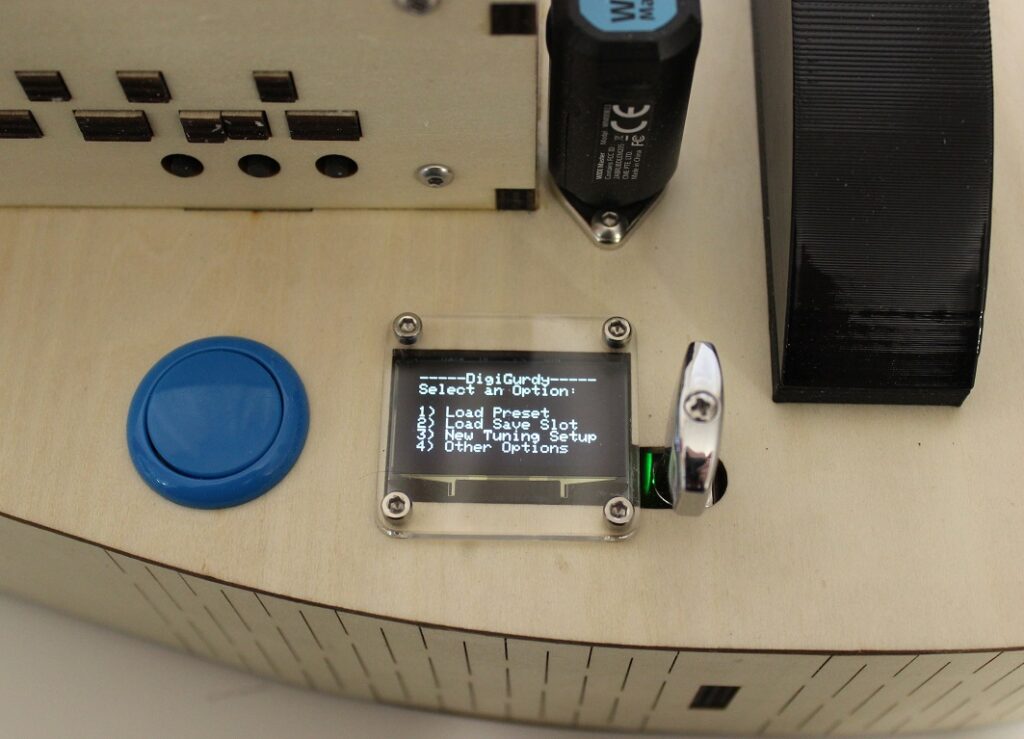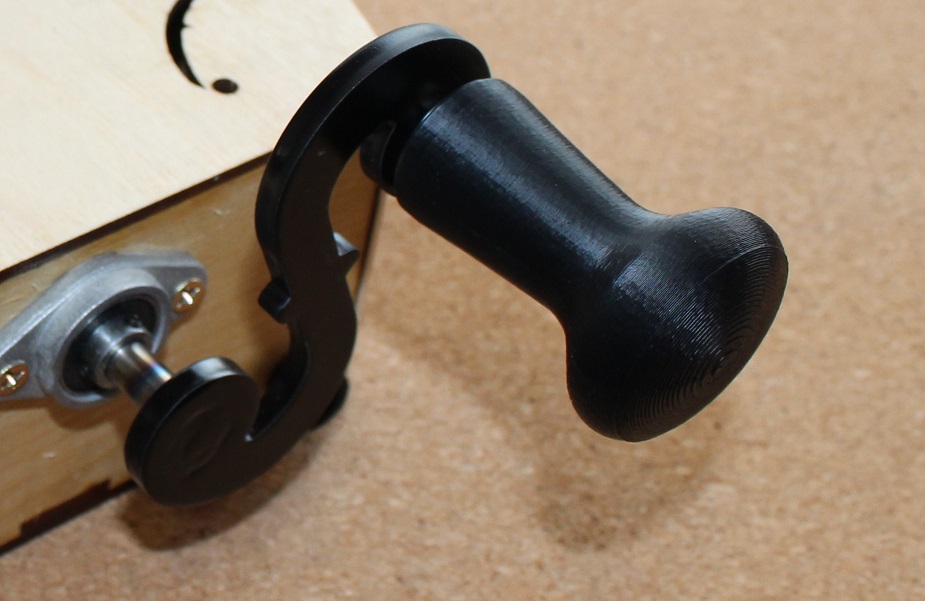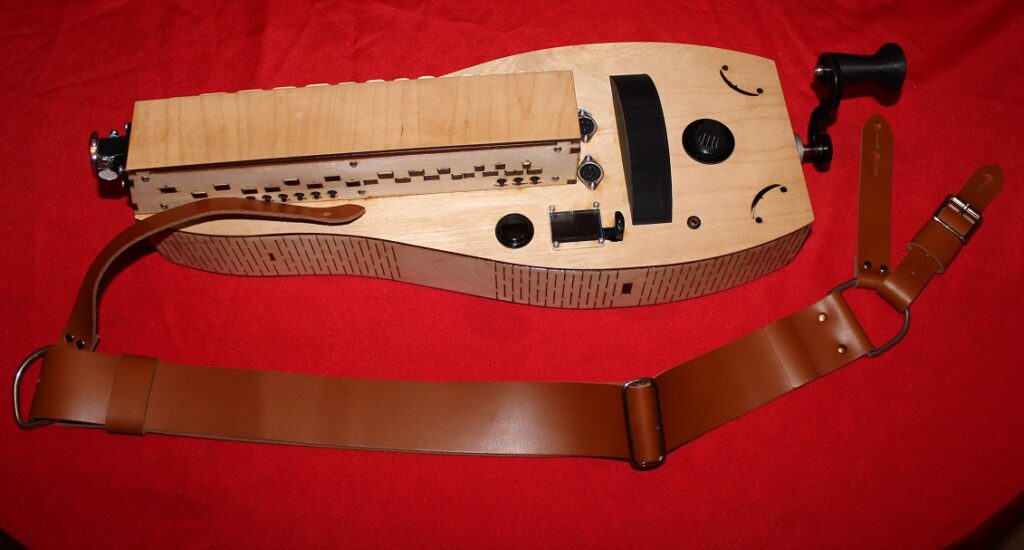The Digi-Gurdy in more detail
The structure is laser cut plywood as this is both cost-effective and resistant to temperature and humidity changes (no sticking keys). Some small parts are 3D printed in tough, UV resistant, ABS plastic as is the wheel cover. This means if you look up very close there is a lined feel to the plastic parts from the way they are built up in layers.
Tuning:
There are now 4 basic tunings offered as presets for beginners. You can choose from these and be absolutely fine.
However there is also the option to create an almost unlimited number of tuning combinations and save them as your own custom presets. Small buttons on the keybox allow you to shift all strings up an octave or down an octave, plus there is a capo on/off button. In addition there are buttons for volume Up/Down, Trompette mute, Drone mute and so on. All are user customisable. This gives you a simpler starting point but as you become more advanced a large number of additional possibilities are there to be experimented with.
A contributor to the project, Basil Lalli has recently re-written my software to include all these extra features.
How does it work?
The keys, which are accurately located as in a regular hurdy gurdy, activate tiny spring-lever switches inside the keybox. In a regular gurdy they would press the strings. Also, in a regular gurdy you can press a key string harder to “bend” notes to give some vibrato. On the DG the note is simply on or off and it does NOT have this vibrato function.
I designed the first one just for myself to learn some simple tunes on. After that people challenged me to add a crank to it. Originally I used a gear-motor turned by the crank to produce a voltage proportional to cranking speed. In this new version I have an aluminium wheel with an adjustable friction pad that simulates the friction of cranking against a set of strings. The ease of turning is adjusted using the tuner peg visible on the upper soundbox. The speed of rotation is now sensed by an optical system. You use the knob on front panel to set the sensitivity of the trompette buzz i.e. above a set (by you) cranking speed, the buzz will sound. Therefore the crank can be played with the buzz sounds as you accelerate the crank during each rotation and this can be adjusted to your personal cranking style.
This Digi-Gurdy has a regular hurdy gurdy shaped body, as users said the original one fell off your lap if trying to crank seriously. They wanted to be able to attach a strap and have the keybox and crank located in space in the correct position relative to their body, replicating the playing position of a real HG.
What do you connect it to?
Option 1. MIDI via USB cable to an iPad: It works very well with an iPad running bs-16i software ($8 from app store) or an iPhone. It can also work with an Android phone as bs-16i has just come out in an Android version (Aug 2023). Personally I prefer an iPad as in the setup videos. The iPad or phone has the audio sounds stored on it in a file called a Soundfont. The Digi-Gurdy tells it which notes to play at any time as it is, in effect, a very unusual MIDI keyboard. The sounds come from this soundfont. You can download the soundfont as it is open-source, to the actual phone or iPad you plan to use with the DigiGurdy.
The DigiGurdy comes with a USB lead. Depending on what type of phone/iPad you want to plug it into, you need a little adapter that goes on the end of this lead and plugs into your phone. For an iPad you will need an Apple USB Camera adapter and I can send you a link where to buy these from.
The DigiGurdy in this simplest set-up arrangement is powered from the attached phone or iPad.
Option 2. Wireless Mode:
It also has a conventional 5 pin MIDI-out socket on its upper surface which will accept a wireless bluetooth MIDI transmitter (not supplied). One example is the WIDI-Master seen in some of the images on this website. If you plug one of those in, then it can connect wirelessly to the phone/iPad. When connected wirelessly the DG then needs an internal battery to power it. I have therefore provided a place for an internal rechargeable battery which is embedded inside left hand end of the DG. These rechargeable batteries are about $7 and if you did later on go wireless, you can fit one of those batteries into the little powerbank module mounted in the end of the DigiGurdy. They are called 18650 batteries (flat cap variant). Contact me if you need more information on this.
Option 3. Internal audio board & headphone socket: Since 2023 I now supply it with an internal audio board, memory card and headphone socket. This means you can power it up, plug in headphones and play quickly if you want to. NOTE: This is also a proper line-out so can be connected to a Hi-Fi amplifier or the AUX-In socket of a guitar amp for example (but NOT the guitar jack input as would blow your speaker).
Software updates:
The computer inside is called a Teensy 4.1. This is a very small but powerful computer.
You can download software updates and and install them yourself to the on-board computer. This procedure, with a step-by-step video for those who have no prior experience doing this is described here: Updates
In addition, any servicing or adjustments can be carried out from the underside, where there are three easily removable access panels.


Short video explaining the internal workings (previous model).
Nigel Eaton playing around with the isolated keybox from one of the development versions.
Connecting it to and setting it up with an iPad (or iPhone).
There was a bug in this but now all fixed. Save your own tunings.
Bi-directional cranking
Jaap trying out improved crank response (used from early 2023 on).
HOW IT IS CONSTRUCTED – in detail.
How to load a software update. These will come out regularly.
I heard you made an aluminium version? Yes I did but these are not for sale. It took me 3 months to make, never again !
Additional Links
Original project as documented on Hackaday website:
https://hackaday.io/project/165251-the-digi-gurdy-and-diginerdygurdy
Link to the Bismarck bs-16i app which is suggested as one suitable app you could use with the Digi-Gurdy on an iPad or iPhone:
https://apps.apple.com/gb/app/bismark-bs-16i/id388149926
Link to the Android version of the bs-16i app you could use if you prefer to connect the Digi-Gurdy to an Android operating system phone such as a Samsung for example.
https://play.google.com/store/apps/details?id=jp.bismark.bs16i
It can also be used with a PC running a DAW (Digital Audio Workstation). Not for beginners but some people are very into this. I have had feedback from people who have done this, if you want to explore that route. Email me for more information.
Notes 14/04/2024:
In the videos the prototype I am using has various extra features I was trying out. The ones for sale on this site at present will have plain unvarnished body and lids in a very pale blemish-free birch ply with laser engraved logo on the lid. Almost zero laser burn marks. It comes with a long USB lead which you plug into your device, such as an iPad and also the very short one to link the battery bank to the USB socket if you want to use internal power. If you wanted to use a Bluetooth MIDI ‘dongle’ transmitter such as a WIDI-Master you would need to purchase that later on. See the frequently asked questions section below for related queries.
Video tutorial on how to insert a battery if, later on, you wish to use the DGurdy wirelessly with a WIDI-Master Bluetooth MIDI dongle plugged into the 5 Pin MIDI-out socket provided. Extra notes 21/3/24: When charging OK it gives regular flashes (red but can also be blue in some variants). When there is a problem charging it gives irregular flashes. When charged the little LED light stays on continuously – same colour as before. Finally, there are some rapid plug-in phone chargers coming on the market called ‘Flash’ chargers that put out more current through their USB lead. Do NOT use one of these to try to charge the DG battery bank, it will not work.
Bags
We do not sell bags at present but if you search online for a ‘badminton racquet bag for 4 racquets’, you will find bags that a Digi-Gurdy should fit into. Bags for 3 or 6 racquets seem more common than 4 and they would probably also be OK, but this one is great, shown here with my original prototype. If in doubt buy a 6 racquet bag and it will definitely fit along with associated leads and a mini-amp maybe as well.

Where can I get lessons?
I have been having lessons online as a beginner from Michalina Malisz who does not mind that I am using an electronic gurdy.
Online music lessons are very much a thing now especially after the events of the last couple of years.
Link to Michalina’s gurdy lessons booking website is here: https://calendly.com/michalina-malisz/experiment1et?month=2022-11
Here is a list, probably incomplete, of people who give lessons. Most have YTube videos if you search for their name + hurdy gurdy. All can be contacted via facebook, if you join the Hurdy Gurdy Community group: Sergio Gonzalez, Ron Höllein, Francesco Giusta, Christian Mohr Levisen, Jon Loomes, Pabs C. Ursusson, Germán Díaz, Sanne Van Gend, Quentin Budworth (I think), Scott Marshall.
Do you sell a strap for it ?
I am collaborating with a leatherworker on a custom Y-shaped strap design, where everything is adjustable. He normally makes saddles and so on so the leather is very high quality. Contact me for more details on this.

Our Mission
To make the best Digi-Gurdys in the world
Some frequently asked questions:
- Is it painted? No. To paint something well takes several coats with sanding in between and so this would push up the price. The ply I use does however have a very smooth surface and there are almost no laser cutting marks at all.
- Do you get a strap with it? Currently no, but I am working on it, see above.
- Do you get the internal battery with it ? No. The battery pack module is provided in the end of the soundbox should you wish to buy a battery yourself locally to make it work wirelessly (with a WIDI-master MIDI Bluetooth dongle). See explanatory video above. Shipping Lithium batteries internationally really is no fun. You can also power it from any regular external mobile phone power bank if you want to via the long supplied USB lead.
- Do you get the WIDI-master MIDI Bluetooth transmitter dongle with it? No. These are available via the usual large internet retailers. A 5 pin MIDI-out socket is provided to plug this into, or indeed to plug in a conventional MIDI lead.
- Do you get wafers with it? Sorry, no. That was a Monty Python sketch (Albatross sketch) 😉
- Will you be selling accessories like straps, carry cases etc? In time most certainly yes. Right now the goal is to sell a good product at a very good price. 4-6 racquet tennis bags work very well.
- Is there a 2 year waiting list? No, currently looking at around 4 months as things stand right now. This could change.
- Do you get the USB extension lead with it with the angled end: Yes! Yes, you do.
- Do you get the Apple camera adapter to allow it to be plugged into an iPad? No, you do need to buy an adapter to make the final connection to your particular device as these can vary according to the device you plan to use. I can give you examples of the correct adapters to buy.
- Do you get a short link USB cable from battery holder to the USB socket (the Magic Cable in one of the videos)? Yes.
- Why does the latest one have two MIDI sockets? Because the March 2023-on version also has a MIDI-in socket and associated electronics. This can be used for inputs from an external pedal set for example, although we have not made this yet. It is an attempt to future-proof the instrument as far as possible.
- What about software upgrades? Information on free software upgrades comes out at regular intervals via the DigiGurdy Facebook group, or you can contact me directly. You can load these yourself by plugging it into a PC/laptop and following a set of steps outlined in the video above. Do not worry, it is not very difficult, especially after the first time.